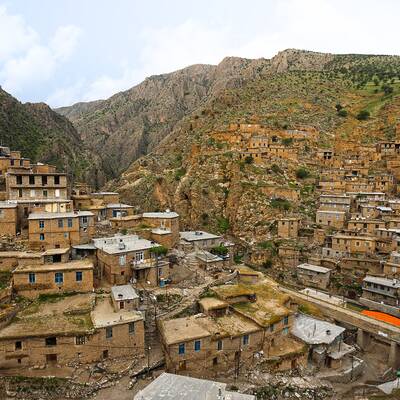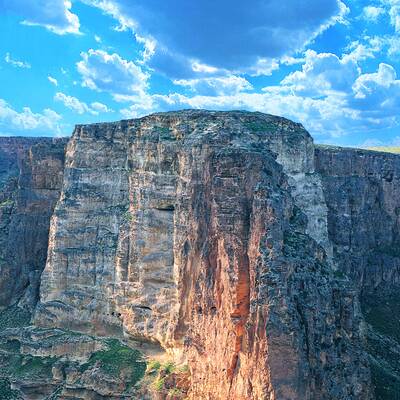Kurdistan is a cold land with warm-hearted people whose hospitality is well-known. The literal meaning of Kurdistan, which was first officially used during the Seljuk period, is the land of the Kurds.
History
The history of the land of Kurdistan dates back to the Medes. In 1337, this province was formed in the way we know it today - with the cities of Sanandaj, Ghorveh and Saqqez - and now has ten cities after the last divisions of the country: Baneh, Bijar, Saqqez, Sanandaj, Ghorveh, Marivan, Divandarreh, Kamyaran, Sarvabad, Dehgolan.
Geography
The green Kurdistan borders the provinces of West Azerbaijan and Zanjan to the north, Hamedan and part of Zanjan to the east, Kermanshah to the south and Iraq to the west. Its people speak Kurdish, and it should be noted that in some parts of this province, people also speak Azerbaijani.
Kurdistan has many forests, most of which are scattered around Baneh and Marivan. These forests contain various types of oak and other trees.
Climate
This mountainous province, which is affected by the Mediterranean climate, has a cool and temperate climate in spring and summer. The spring rainfall and heavy winter snowfall are due to the same warm and humid Mediterranean air masses.
Spring and summer with an average temperature of 22 to 25 degrees Celsius are a good time to travel to the cities of this province. However, nature lovers can always travel to the cities of Kurdistan in winter.
Cities of Kurdistan Province
A long history, rich culture, festivals, handicrafts in different cities of the province, untouched nature and beautiful attractions have turned this province into an amazing destination for tourists. Let's see some of the cities of Kurdistan province together.
Sanandaj
Located between the Zagros mountains and Abidar mountain, Sanandaj is the capital of the province. The city has a cold and almost dry climate. Its history dates back to before Christ. During the Safavid period, a fortress was built in Sanandaj and prosperity began in this region from that time to reach its peak under the reign of Qajar dynasty. According to historical writings, the name of the city is also derived from the Safavid fortress, "Sene-Dej".
The existence of numerous mosques in the city has made Sanandaj known as the city of mosques or minarets.
Some of the attractions of this historical city include:
The Jama Mosque of Sanandaj - a remnant of the Qajar period
The Abidar Recreational Park complex with several gardens and a summer open-air cinema
The Sanandaj Bazaar, which was built in the 11th century AH
The Kurdish House or Asef Mansion, which is now the Museum of Anthropology; It was built during the Safavid period and completed in later periods
Chaharbagh and Khosrowabad Mansion
The Vakil Mansion, parts of which were built during the Zand period and other parts during the Qajar period
The Moshir Divan Mansion
Khan Hammam
Imamzadeh Hajar Khatun
Imamzadeh Pir Omar
Imamzadeh Pir Mohammad, located on top of a hill in the old city cemetery
The Moshir Mansion
The Amjad al-Ashraf Mansion
The lake behind the Qeshlaq Dam
Dehgolan Plain
Negel Village (on the way from Sanandaj to Marivan)
Salavatabad village
Koochsar Mountain
Sheikh Mahmood Mountain
Mirza Mosque Mountain
Mullah Kaveh Mountain
Charkh Lan Mountain
Seraj al-Din Mountain
Qeshlaq Bridge
Baneh
Placed in the west of Kurdistan, Baneh is the land of oak forests, and of course, walnut, wild pear, ziziphus and mazwood trees. The name of the city is derived from the Kurdish "Ban" meaning roof, which refers to the heights and location of Baneh. Baneh is known for its border markets, but the city has include other attractions, including plains and forests, Hossein Koohkan Stone Cave, built by a man of the same name, Shoy Cave, Arbaba Mountain, Dokanan and Pir Morad mountain parks, Haftash village, Shoy village, Mamal village, Sabadloo village, Nezhoo village, Najneh-ye Olya village, Various shopping centers and malls.
Marivan
This city, which was located on the route from Ctesiphon to Takht-e Soleiman, was highly strategic during the Parthian and Sassanid periods and is still a significant city in Kurdistan province today. There are different stories about the name of this city: according to the first one, Marivan was once the center of forest products such as gum tragacanth and tree manna. People from Merv came to the region in order to trade and buy these products. They settled here and named the city Marviyan, which changed over time. Some also say that the presence of ducks in Lake Zariwar (Morghabi) caused the city to be called Maraviyan or the place of ducks. Maravi in Kurdish means duck. Remarkable among the spectacular sights in Marivan are Lake Zariwar, which is the largest freshwater lake in the country, Zariwar Coastal Park Complex, Bilu Plain, Marivan border market, Qomchian recreational area, Kani Sanan village, Imam or Marivan Castle, Garan historical bridge, Chehel Cheshmeh Mountain, Mulla Qubi resort, Marivan forests, Uraman Takht, Daraki village, Kani Charmeh mountain, Sanasareh mountain, Miyaneh mountain, Piazeh mountain, Uramanat inscription, Takht mountain and religious places.
Saqqez
The name Saqqez, located in the north of Kurdistan, is derived from the Scythian people who lived there during the Median period. Some of the main sights in the city that invite tourists to Saqqez are Karaftu Cave, Sheikh Mazhar Mosque, Baba Sheikh Tekyeh, Paptoos playground, Haj Hakim Nilufari Tomb, Saqqez River, Shahid Kazemi Dam Lake, Sheikh Hassan Molana Mosque, Sheikh Hassan Molana Historical Quran, Domenareh Mosque, Haj Saleh Hammam, Ziwiyeh ancient castle, Bastam border market.
Bijar
Bijar dates back to before Christ, and its proximity to Zanjan and West Azerbaijan has led most people in Bijar to speak Turkish. The city is one of the wheat production centers in the country and is also known as the granary of the west. The attractions of this city include The Seyran River, Bijar Plain, Oshqun Baba Brick Tower, Bitter Water Spring, Qamchqay Ancient Castle, Bijar Protected Area, Yengi Arkh Tower, Uch Gonbadkhan Tower, Gol Qeshlaq Bridge, Salavatabad Bridge, Qajor Bridge, Imamzadeh Aghil, Sarab Gorgin Hill, Chogha Hill, Ghaleh Hill, Qaba Sorkh Hill, Khosrowabad Grous Mosque, Old Castle, Banu Castle, Imamzadeh Hamza Arab, Sahebeh Khatoon Tomb, Seyed Mosayyeb Seyed Shokr Tomb, Yasukand Bath, Imamzadeh Khader, Chal Tepe, Chaharbagh Grous, Bijar Traditional Bazaar, Nesar Ski Resort, and many small and large villages in the region.
Some other attractions in Kurdistan:
Baba Gorgor Mineral Water Spring
Badr and Parishan Protected Area
Farhadabad Bridge
Sangin Abad Waterfall
Farhad Tash Historical Cave and Rocks
Sarab Kowsar Lake
Ancient Hills
Dar al-Ihsan Mosque
Qorveh Plain
Panjeh Ali Mountain
Hossein Bek Mountain
Qaslan Bath in Qorveh
Palangan Kamyaran Village
Kamyaran Plain
Amir Abad Plain
Govaz Kamyaran Mineral Water Spring
Goyileh Waterfall on the Marivan to Saqqez road
Avalan Mountain
Seyran River
and numerous hills, mountains, as well as religious places in this province attract a large number of tourists.
Accommodations
The hotels and guesthouses of the province are comfortable places for travelers to stay.
Varan Rural Eco-lodge in Galin Village, Tishk Rural Eco-lodge in Dolab Village, Zhin Rural Eco-lodge, Mirza Saeed Obato Rural Eco-lodge in Divandarreh, and Neshingai Benar Rural Eco-lodge in Marivan are suggested to experience village life and enjoy the traditional atmosphere of Kurdistan.
Local foods
Shalkineh, which is made from flour, milk, eggs, and salt, Qayremeh, cooked with thistle, rhubarb stew, Kurdish Leek stew, Perpuleh Ash, Sehnegah Sir Ash, Danekalaneh Ash, Kalaneh, Lentil Bulgur Ash, Kurdish Dough Ash, Doghin Ash, Halava Ash and Savar are just a few of the delicious local dishes that are prepared in different cities of this province.
Pea pods, which are sold by vendors, are also a delicious snack in Baneh and some other areas.
Restaurants
Some of the restaurants in the cities of Kurdistan include Sadaf and Zeytoon Restaurant in Saqqez, Morvarid Restaurant, Jahan Nama Restaurant, Abidar Restaurant and Traditional Tea House are a few options in Sanandaj.
There are many stalls in Baneh and other cities that sell baked potatoes and eggs. The vendors wrap it in bread with herbs, which is suitable for tourists who are adventurous and want to taste the real taste of the cities.
Handicrafts
Hand-woven carpets of Bijar, Bukan, Sanandaj and Afshar are among the most important handicrafts of Kurdistan province. Sanneh Gilim, wood carving, Kalash (Gīveh), making musical instruments and tools are other handicraft activities in the province.
Souvenirs
Bijar Shirmaal bread, Komaj and Bijar Halva Sohani, various types of roasted seeds from Saqqez, traditional sweets such as roasted almonds, sesame gazangabin and sugar sweets, Barsaq, Saqqez, natural honey and oil, rice bread, Kaak, Basloq, various types of dried fruits and raisins are among the souvenirs that can be purchased from different cities and places in Kurdistan, in addition to handicrafts.
Customs and Traditions
Kurdish dance is the first feature we remember this province with, and most of the ceremonies in Kurdistan are accompanied by this dance.
Many ceremonies have been performed in Kurdistan in the past. Mir Nowrozi, Kooseh Gardi ceremony, Mir Mirin or Amir Bahadori are some of the traditions that are more or less forgotten today.
The Samanoo Pazan ceremony is still performed in some villages.
The festival of Pir Shalyar, which is a thousand years old, is performed every year before Cheleh Koochak. On the last Wednesday before February 5th, the wedding anniversary of Pir Shaliyar is celebrated in Uraman Takht. In this ceremony, people sacrifice cows and sheep, play Daf and distribute votive food. The tomb of Pir Shaliyar is located in this region and it is said that he had a charisma being able to cure the King of Bukhara’s deaf-mute daughter with the help of God and eventually married her.

